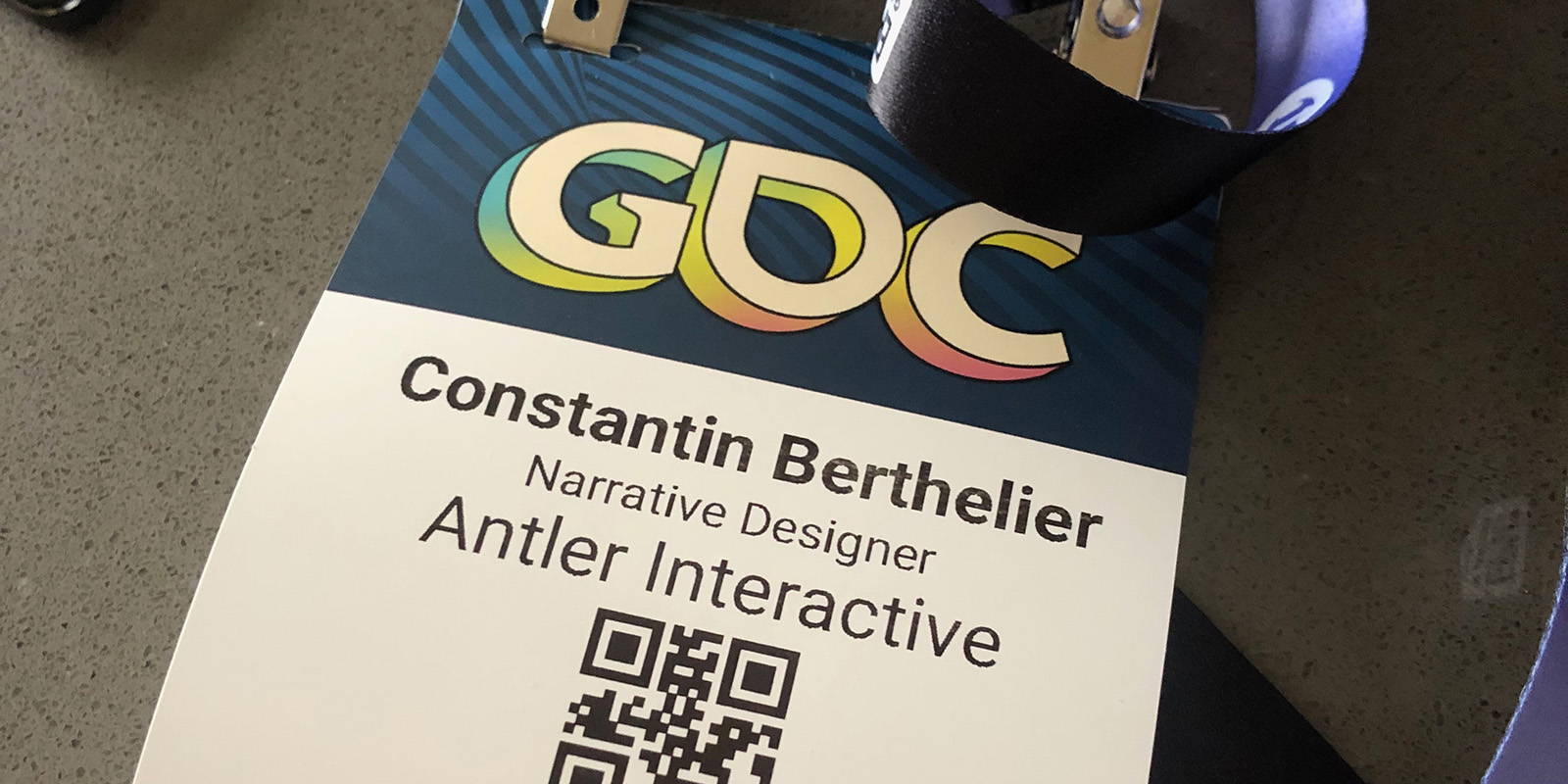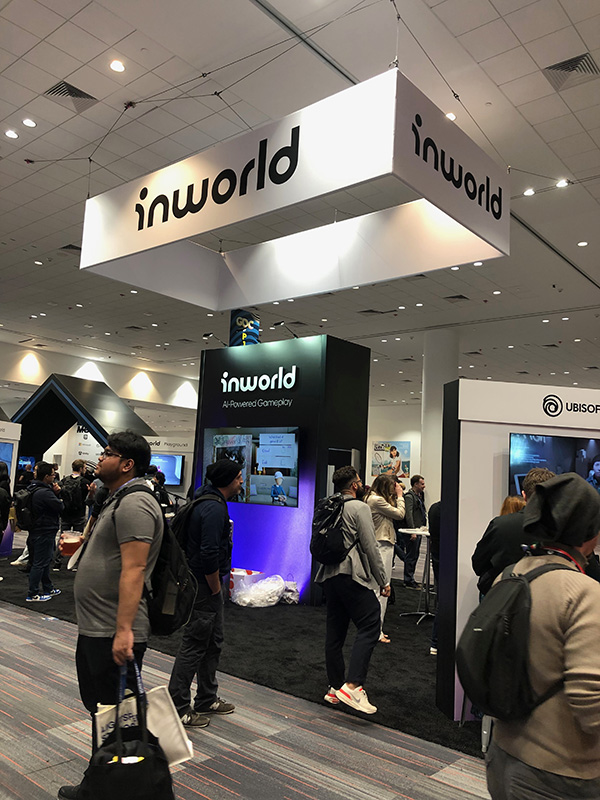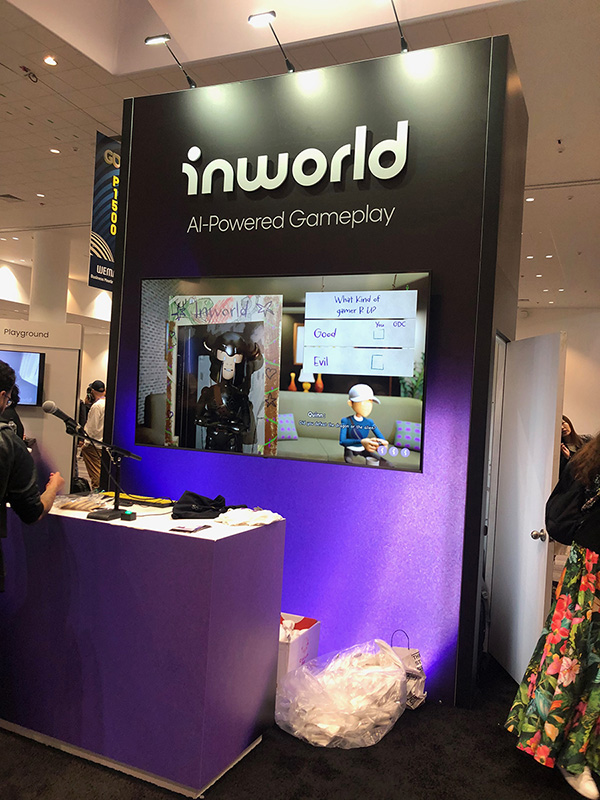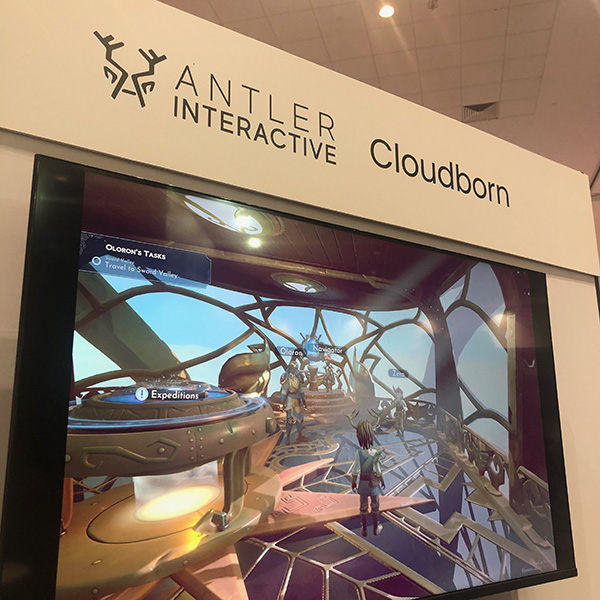
2024 was the year of the warm-up
This year, I headed to San Francisco on behalf of Antler Interactive, where I work as the in-house Narrative Designer. Accompanied by my boss Lenny and Oliwer, our Creative Director, we presented Cloudborn, our newly announced title.
Just a few weeks earlier, we hadn’t planned on hopping on planes to spend a whole week in an exhibition hall on the other side of the world, but here we are—everything changed. And it’s not an exaggeration to say it changed because of two letters now seen everywhere: AI.
A bit of context is necessary. Our visit to GDC was accelerated by a partnership between the development of Cloudborn and Inworld AI. A partnership we initiated early, when Inworld was barely making its debut on the AI tools scene for video game development.
It was a real chance, not to say an opportunity, that we got to showcase our game at the expo, a game designed for web3, but that blends seamlessly with the new features offered by Inworld AI. We quickly realized how lucky we were to have been chosen by them to feature on their booth, as well as that of the Blockchain Games Alliance.



Even at GDC, Inworld’s AI Provokes a “Wow”
On the way to the GDC, I was sure about the demo we were going to show at the Inworld booth. Yes, the flow of this demo was good, the team had worked incredibly hard, the graphics were stunning, and the UI was spot on, but I thought our narrative secret weapon—AI-driven NPC characters—wouldn’t impress many. Fortunately, I was wrong.
Indeed, I had underestimated the GDC audience, already well-informed about these emerging technologies, and I imagined everyone had already seen demos of characters interacting through an LLM. I expected shoulder shrugs from an audience for whom ChatGPT was old news and who were seeking the thrill of the next big thing. Instead, I can affirm that nearly all testers expressed surprise as they unlocked a passage to a cave blocked by a giant sword, after negotiating with our brave character, Vendahlor. A unique character, whose dialogues, instantly generated from player input, were 100% created by artificial intelligence.
Yet our array of testers was diverse. We had visitors ranging from aspiring game developers and students to AI researchers from companies like NetEase, Bandai Namco, and even Square Enix. Other major studios represented included Sony, Tencent, and 2K Games, and I’m pleased to say that everyone was enthusiastic, evidenced by the many questions we were asked.
And for some reason, I particularly remember a tester who approached me with a character idea he described immediately after the demo. He painted the picture of a veteran soldier who has seen a lot, knows a lot, but always talks while drunk, and therefore, ironically, is unable to share his memories clearly. He said it would be great to be able to talk to such a character in a game, but that with today’s tools, it wouldn’t really be possible. To this remark, I promptly replied that all he needed to do was write his character exactly as he had just described. Nothing more. Adding some details would always help to enhance the character’s expression and diction. But this visitor immediately understood where I was going; he just needed to execute his overall idea. The rest, that extra spice that makes one AI-speaking character better than another, would come with study and practice.

AI, AI, AI.
Yes, the word was on everyone’s lips, with every conversation at the expo. But it wasn’t quite everywhere yet. Startups offering AI tools to assist developers were not necessarily very visible and had not yet secured the prominent places like Inworld.
You had to look to find Meshy, an AI capable of generating 3D assets from a simple prompt, likely to be integrated into a production pipeline. You had to browse the directory to meet the people behind XandImmersion, an AI that could assist a storyteller in managing their universe and thus generate endless content.
There was also a certain restraint, I suppose, because this year, more than ever before, the GDC opened in the dire context of an industry widely described as sick, plagued by massive and brutal layoffs. With, and everyone had it in mind, the rise of generative AI lurking, widely seen as likely to replace entire segments of the game development industry, with the fear that workers might ultimately never be rehired.
In this highly particular context, a few months after ChatGPT was described, even by my colleagues as “the tool that replaces the screenwriter,” being present at the GDC with a title offering a cutting-edge AI experience, still today in close collaboration with Inworld AI to develop crazy things in Cloudborn, it’s time for me to reflect.
Writing, Anyone Can Do It
I’ll start with this assertion: anyone can write. I start here because since Midjourney became part of our lives, we’ve been given this dizzying impression that now, anyone, without training or study, is capable of generating visual work that can compete with artists who have years of training and professional experience. Injustice was the first widely shared feeling on social networks. This dispossession of hard-earned knowledge was unbearable, and I understand that. And the question remains: whose turn is it next? Voice actors are largely replaceable by Eleven Labs as I write these lines. And as far as our industry is concerned, judgment day will come when anyone can “prompt” directly in Unreal or Unity without having to code.
But this dispossession, we Narrative Designers have always, always lived with. Because yes, a Narrative Designer constantly lives with the widely shared idea that writing and, moreover, telling a story, is within anyone’s reach.
It’s something that stays with us, with which we live, work, and learn. I have proof of this in the imposter syndrome that is very present among Narrative Designers. If you are not convinced, simply ask my fellow Narrative Designers, or browse LinkedIn looking for posts issued by Narrative Designers, I guarantee it won’t take long before the subject is addressed.
This feeling is all the more amplified because we often have to compose within a game studio with other developers endowed with complex, meticulous expertise, which, according to legend, requires a specific brain training and thought arrangement for the exercise of certain professions. This is added to years of study, practice, and training. Inevitably, our talent as Narrative Designers, even endowed with respectable training, will be immediately perceived as a frivolity, the futile expression of a fluttering mind, and terribly difficult to judge on the spot. Yes, even artists do not suffer from this pitfall. Although very harshly put into competition, their work is easy to judge, and a talent will easily emerge from the rest at a simple glance. Which again, is much less obvious for a Narrative Designer.
Why then does this idea persist? Perhaps because it is probably also a truth. And I will affirm it myself. Yes, writing fiction, as long as you have a minimum mastery of your language, with a minimum of style and correct syntax, is possible. I would even go as far as to assert that anyone working in a game studio possesses, a priori, sufficient writing skills to produce a comprehensible story. Game studios are indeed populated by graduates, who are very likely there out of vocation, and are therefore driven by a minimum curiosity about fiction and narratives, in general. Which makes it, in my view, more than sufficient as a prerequisite for trying to construct stories. It’s stating the obvious to say this, so I have never wanted to unnecessarily mystify my profession, and I invite every Narrative Designer not to wrap their expertise in complex concepts solely to mistakenly establish some kind of authority within a studio.
Even though I admit, this feeling of insecurity sometimes leads us to lack humility and wisdom. And I doubly forgive, knowing that sometimes, and not infrequently, a team expects from the Narrative Designer that bit of mysticism, or even oddity. From there to the clown act or the therapy session, there’s unfortunately only a step, one that must be avoided.

AI, Anyone Can Do It
The reason I mention this state of affairs is that now, yes, absolutely anyone can produce an image through the medium of a simple prompt in Midjourney or ChatGPT, almost for free, in a few seconds. Yes, I can now make concept art. I can’t help it, but that’s just how it is. And concept art, to illustrate my stories, my pitches, I’ve done a lot of it. I’ve done a lot of it under Dall-E 3, which is more than sufficient for the use I make of it. I’ve done it for Cloudborn, and for other projects. I then remember what it implied to ask for concept arts for personal projects from artist friends a few years ago. It’s simply incomparable.
What professions might I practice tomorrow? 2D animator? 3D modeler? 3D animator? Unity programmer? Nothing prevents me from dreaming. I’ve seen AI models at the GDC, like Meshy, capable of producing 3D assets generated from simple prompts that I could send today into a 3D production pipeline. And this is just a warm-up. The promises made by other startups were numerous, crazy, and at the same time, given the progress already made, I don’t see how the machine could stop in such good stride. So, I want to believe that these promises will be kept.
So there you have it, we’re there. Everyone can just as well make concepts, do dubbing in any language, and soon produce 3D assets, just as everyone can write a text. Here we are. What we storytellers have felt from the beginning, you feel it. What we have learned and evolved in, what we have toughened our skin in, you are there. And the question remains the same. You know how to write an email so you can certainly write fiction. That’s absolutely true. But now, what will you write?
For What Changes?
Before concluding on the question previously posed, I would like to clarify that it is quite easy for me to express myself in this way because I enjoy the extraordinary privilege of evolving within a studio, Antler Interactive, which lets me explore such tools and has embraced them in its production. Beyond even that, I can now rely on a shared enthusiasm within the studio for these technologies. I fully understand that a fellow Narrative Designer, who may not be able to benefit from such support, might be reluctant to embrace these new tools. However, I dare hope that these next paragraphs might change their mind.
Living Characters

One might think from reading me that nothing or almost nothing has changed in my profession, and that would obviously be wrong. Often the question has been asked of me about the change, for better or worse, that has occurred in the flow of my workdays. And even with a real effort at objectivity, I would still have trouble hiding my enthusiasm. Yes, AI is a paradigm shift. It does not replace my production of ideas, but it breaks down the barriers between the idea and its execution. More than that, it is this electric, magnetic impulse that sets a vision in motion, gives it life, gives it body, and directly expresses my intention to the player.
Just like Rob Vel who gave life to Spirou in those two mythical panels where he stages himself sprinkling his drawing with “water of life” so that the character animates, steps out of his frame, and “serves” the reader, I can now, thanks to tools and technology from Inworld, bring characters to life. These characters will first and foremost follow my intention, just as a written intent note for a film or a game would give body to everything that follows: a scenario, a storyboard…
This image of Spirou coming to life is particularly evocative to illustrate the case of our demo at the GDC, where at one point, I felt like our two characters were actors playing on stage, always staying in their roles. Once the conference was over, I was proud of them as I would have been of two actors whom I would have had practice for weeks ahead of their public performance. And it is a realization that from now on, my work lies here. I have become at once a role-player, but also a conversation designer, a playwright, and a character maker. Characters that I don’t write in one go, but that I shape around the conversations I have with them, to then polish them based on what others tell me about them. All of this is quite new.
Living Worlds

A character cannot exist without his universe. Even a character we would want to be part of our world and our era would need landmarks and context, in addition to what the LLM is capable of extrapolating. Thus, anyone who would want to make characters talk using artificial intelligence would inevitably need to create the universe in which to make them evolve. No, it will never be enough to write a simple character in a few lines and press a magic button for AI to do everything else. You will need to arm it with a solid base of knowledge and logic, all with as much coherence as possible. One thing I have learned with characters working under Inworld is that they will very quickly highlight any inconsistency in the world in which they live. So yes, you will need to anticipate the blind spots and prepare successive layers of facts and rules so that your character can rest on them with the most comfort possible. Only then, once this work is done, can you hope to make them breathe fire. Not before.
In this regard, I have gradually realized, as I worked on my worldbuilding, that all these rules that I wrote, while I filled out my Excel spreadsheets, that all this content was going to be of utmost importance. Because with AI, everything counts. Even the most obscure, the most bizarre rule of the universe can at any moment be called upon by the model to be retranscribed by a character. From now on, your iceberg is completely emerged. Everything must make sense, because you will no longer have any cover-up. Rejoice, dear fellow Narrative Designers, your worldbuilding bible will no longer be that document that lingers at the bottom of a Google Drive and that no one will ever read.
In realizing this, I felt like the D’Ni, those world creators in the Myst video game saga, which I adore. These world makers are masters of Writing, and they indulge in the fabrication of worlds that they describe with words, in magical books. Books on which it is then enough to place the palm to be able to teleport there to visit them. And with AI as in Myst, you will need to balance the world, think about the smallest rules that define space, time, physics, societal stakes… because your character will never indefinitely respond “I don’t know” to your player. And you wouldn’t want them to be too creative and fabricate facts you didn’t intend.
Yes, it’s a massive and never-ending job. If you thought AI was going to take away our narrative work, then it’s probably time to reassess your judgment.
